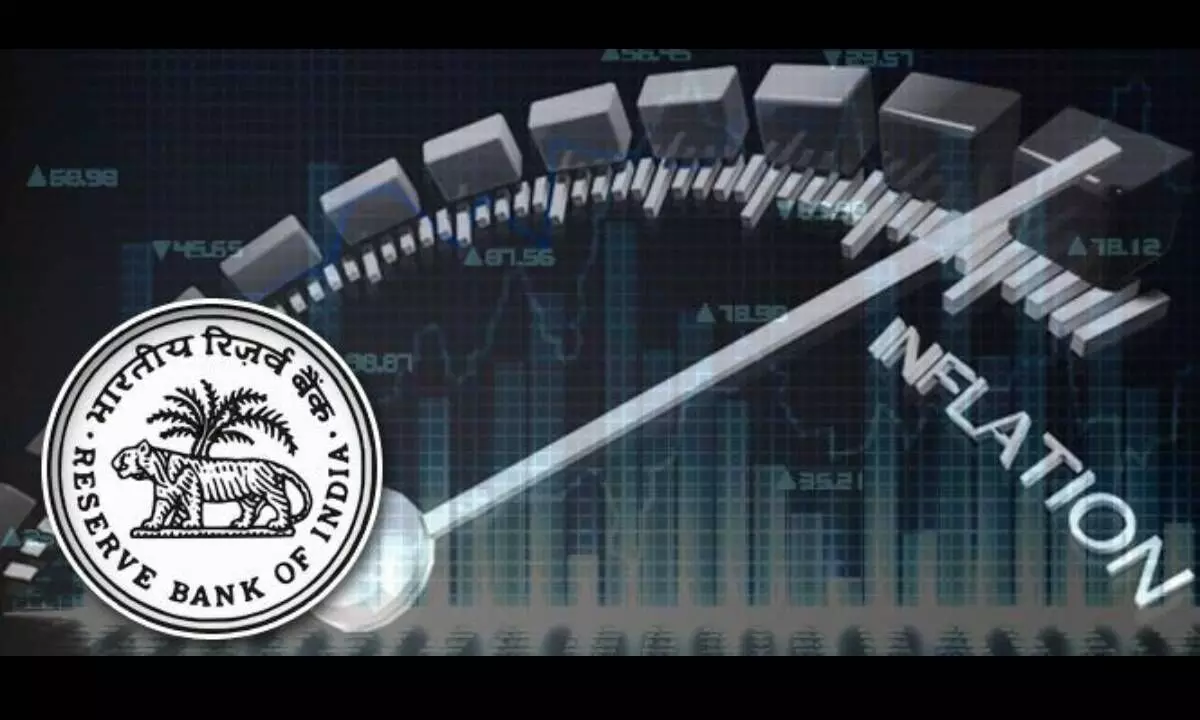RBI’s recent actions have kept inflation at a steady level, opine economists
Centre’s approach has a significant impact on the country's inflationary condition.
image for illustrative purpose

The actions and strategies of the Reserve Bank of India (RBI) - increasing Repo rates by 250 bps since last year, incremental cash reserve ratio (ICRR) - and the Union government’s export controls have ensured that inflation is relatively under control, opine many economists.
India’s central bank, the RBI, acts to control inflation through its monetary policies, while the government does that through governance, infrastructure development that brings down the transaction costs and other ways, they added.
“RBI’s views inflation largely as a monetary phenomenon. Whether the inflation is due to supply or demand, and whether it is driven by core or non-core components, it believes that monetary policy intervention is required if the inflation rate breaches the tolerance zone,” said Sujan Hajra, chief economist & executive director, Anand Rathi Shares and Stock Brokers.
As a result, the RBI bases monetary policy on headline retail inflation (changes in cost of commodities, goods, services) rather than core retail inflation (changes in cost of services and goods excluding food, energy sectors).
According to Hajra, the RBI, with its mandate for growth support, strikes a balance between inflation management and growth promotion.
“Consequently, it may maintain an accommodative monetary policy stance to encourage growth even if the central bank is concerned about the current inflationary environment. Similarly, during periods of adequate growth and relatively low inflation, it frequently takes proactive steps like tightening monetary policy to prevent inflationary pressures from building up,” Hajra added.
According to Hajra, RBI's actions aim to stabilise inflation around the target rate over the medium term. Furthermore, in addition to present inflation and the likely inflation in the future, the bank’s actions take inflationary expectations into account.
“As of now the Monetary Policy Committee (MPC) has retained the repo rate at 6.5 per cent, and continues with the withdrawal of accommodation stance. This was accompanied by the incremental cash reserve ratio (ICRR) which drew out Rs 1,00,000 crore of liquidity. Therefore from the monetary side, the RBI is doing everything possible to control inflation,” said Madan Sabnavis, Chief Economist, Bank of Baroda.
Experts were of the view that RBI’s actions had resulted in inflation being at a relatively steady level.
“To the extent possible, it has (RBI’s actions) worked. The RBI is keeping to a 1% real repo rate goal and hence will be tracking inflation. Monetary policy anyway cannot control food inflation when supply issues drive prices. But as long as headline inflation is high, the RBI will hold on to the repo rate without ruling out a hike, if data warrants,” Sabnavis said.
According to Hajra, as a major lower middle-income emerging market economy with a high weightage of food products in the retail inflation basket, India has not experienced protracted periods of retail inflation in the double digits in the last three decades.
“Yes, there have been periods when the current inflation rate has been much higher than the RBI's inflation target. In several of these circumstances, it has purposefully allowed higher inflation, either to stimulate growth or because it believes the short-term surge in inflation is temporary. Based on the foregoing, it appears that the central bank’s inflation-control strategies have been effective,” Hajra said.
On the steps taken by the central government to control prices, Hajra said the government's behaviour and policies play a significant role in the country's inflationary condition.
“Food inflation is the most volatile component of retail inflation in India. Food inflation, in turn, has a strong positive link with the administered prices announced by the government under the minimum support prices for roughly 30 agricultural products. Over the previous decade, the government has attempted to keep increases in minimum support prices minimal in order to keep food inflation under control,” Hajra said.
The government's supportive policies also include legislative initiatives such as the implementation of the goods and services tax (GST), which has decreased market fragmentation and hence increased price discovery for a variety of items.
“The Central government strategies to sustain local supply of certain food products through export control and measures to increase imports for products with big domestic deficits are likely to assist containing inflation in the final months of the current calendar year,” Hajra said.
On export controls, Sabnavis said it will help only at the margin as once supply trails, demand prices will remain high.
“The government has used export curbs more aggressively this time, though there have been repercussions in case of onions where the farmers are protesting. To counter this, physical stocks have been procured at export prices to assuage them,” Sabnavis pointed out.
According to Hajra, the government, by focusing on fiscal austerity, has taken steps to ensure that the money supply does not increase significantly, which would have a big feedback effect on the inflationary scenario. Further, improvements in infrastructure, including payment infrastructure, have lowered transaction obstacles and transaction costs, which has a positive feedback impact on inflation control.
While the weather played spoilsport and was the cause of the rise in food prices since July, the arrival of a fresh crop by the end of the current calendar year is likely to alleviate domestic supply constraints significantly.
But again, the monsoon effects have been erratic and sowing has been affected for pulses, groundnut and cotton.
“It is believed that the sowing part is almost over and hence we can expect some shortfalls in output in these segments. This will keep prices under pressure as prices of pulses have already moved up based on this expectation,” Sabnavis said.

